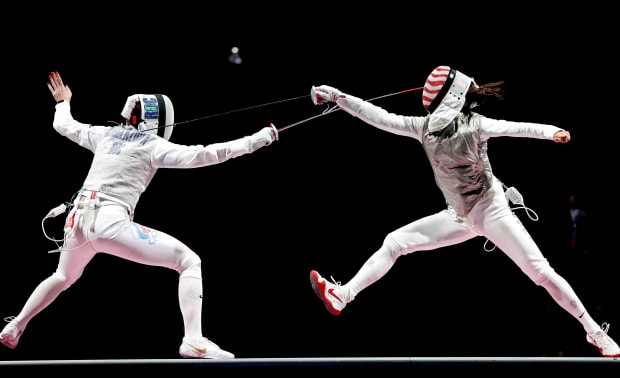Not that long ago, the world’s most decorated swordsmen settled scores in arranged combat. One duel-hungry media member even got in on the, uh, fun.
It’s already been a history-making week in Tokyo for the U.S. fencing team, as Lee Kiefer became the first American to win gold in the women’s individual foil. While the men struggled in the individual events, they are heavy favorites in the team foil. The women could conceivably medal in that event as well. And let’s not rule out the épée and sabre teams. Even if they don’t come home medalists, they’ve done a wonderful job just getting to this point. They’re making their country proud—and I’m not just saying that because they could come after me with a sword.
A hundred years ago, though …

Olympic fencing looked very different in 1920. There weren’t, for example, any female competitors (the first didn’t arrive until ’24), let alone any female med school students, like Kiefer (whose husband, Gerek Meinhardt, is also in med school … and is also a member of the U.S. foil team), competing. More typical was someone like Nedo Nadi, who fought for Italy in World War I before winning his five gold medals—two individual and three team—at the Antwerp Olympics, a single-Games mark that stood unsurpassed until 1972, when Mark Spitz picked up seven in Munich.
Nadi’s younger brother, Aldo—who would later move to the U.S. and coach Hollywood stars like Douglas Fairbanks and Errol Flynn, and be called the greatest swordsman who ever lived by Time magazine—was also a member of the 1920 Italian team, winning three team golds and one silver. Perhaps the most interesting thing about the brothers Nedo, though, was that they both fought duels against the same Italian sportswriter, Adolfo Cotronei, a sort of interwar Skip Bayless with a death wish.
Dueling was commonplace among early blue bloods across Europe, where, according to The New York Times, some 40,000 aristocrats died in man-to-man combat between 1600 and 1789. By the 1900s, this form of score-settling was far less prevalent. In Italy, the practice was outlawed by Benito Mussolini (who himself nearly killed a newspaper editor in a 1921 duel that lasted 75 minutes). But swordfighting, historically, is intertwined with military combat, and so in the days following World War I, as Europe was gripped by nationalistic fervor, competitive fencers were prone to settling disagreements with duels. As Aldo wrote in his autobiography, The Living Sword: “When provoked, the fencer—assuming that the centuries-old traditions of his business have properly permeated his mind and heart—does not and must not argue. First, he fights. Although, later, he may argue.”

Both Nadi brothers served in the Italian cavalry in World War I. Aldo was originally in the infantry, but in his book he explained the four reasons he hated that assignment: He didn’t like walking; he found it unrealistic, at 130 pounds, to be expected to lug around a third of his body weight in gear; he was prone to catching colds; and he found that the company, “comprised mostly of peasants, was unbearable.” “I loathe peasants,” he went on. “Their job and work may be noble and inspiring and all that, but I just hate their dirt, ignorance and prejudice.” (Suffice to say, Aldo does not always come off in the best light in The Living Sword, almost half of which is devoted to documenting his romantic exploits, including a brothel visit when he was 14. The book, at times, reads something like what a letter from Alexandre Dumas to Penthouse Forum might have, interspersed with tawdry details such as: “Wasn’t it enough that I should the night in her bed, enveloped in the most beautiful, finest silk sheets ever dreamed of?”)
Before the Great War, Nedo and Aldo had been raised by one of the leading fencing instructors; their father, Beppe, taught them from an early age. And postwar, in Antwerp, 26-year-old Nedo established himself as the very best in the world. Aldo, with his own medal haul, at just 21, wasn’t far behind.
It was perhaps in Belgium for those Games that Aldo was introduced to the art of the duel. His book doesn’t mention it, and details are scarce, but he supposedly fought an impertinent member of the Italian weightlifting team. Nadi, it was reported, dueled with a riding whip, while his opponent wielded a wood beam. The affair ended quickly when Nadi knocked the weapon out of his foe’s hand.
Aldo’s beef with Cotronei—an Italian fencing editor known for his overzealous prose; or, as Nadi says in his autobiography, “the most powerful and redoubtable gentleman of the whole Italian press”—is far better documented. In early 1924, Aldo attended an exhibition between Lucien Gaudin of France and Candido Sassone of Italy. It was a big deal; Mussolini was there, and Nadi was taken to meet him. Since the match was an exhibition, no score was kept. Nadi, though, ran his own unofficial tally, and at a luncheon the next day he remarked loudly how Gaudin had clearly won. Which riled Cotronei. Upon hearing an Italian assert that his own countryman had lost to a Frenchman, the offended editor shot Aldo a dirty look. A few days later, Cotronei published a story declaring that Sassone had been the victor. He even invented a score, 9–7.

Nadi was convinced that Cotronei had acted out of national pride. “[T]his was Fascist Italy,” he wrote, “and no champion belonging to fascist Italy could possibly be defeated by any foreign and non-fascist champion, let alone in the presence of the Number One.” Whatever the reason, he would later declare Cotronei’s reporting, with perhaps a touch of hyperbole, “the biggest lie of the century.”
Not long after the luncheon, Nadi got word that Cotronei, in Milan, had called him a “mascalzone,” which only sounds like a Taco Bell fusion dish, but in fact roughly translates to “rogue” or “rat.” Nadi was on the next train to Milan.
The duel itself took place in the paddock of a horse track. Each man was armed with an épée and, per the Italian code duello, each was shirtless, wearing dress shoes. For all of its belt-notching, The Living Sword has a remarkable chapter on dueling in general and l’affaire Cotrenei in particular. For Cotronei, a skilled swordsman himself, it was his fifth. But this was the first proper duel for Aldo Nadi, who quickly realized how different the fight would be from fencing, in which the object is to bide your time and attack strategically. In dueling, the object is to go fast and furious, so as not to allow one’s opponent the chance to get comfortable. A fencer who nicks an opponent on the arm a split second before getting hit in the gut scores a point. A dueler who nicks an opponent on the arm a split second before getting hit in the gut could be in the market for a new spleen.
Upon arriving, Nadi walked past two doctors (each combatant brought one) setting up what he described as “a hideous assortment of surgical instruments.” The assistants, or seconds (of which each combatant brought two), laid out the ground, a strip roughly 30 yards long and marked at each end with a stake. If a fencer retreated past that limit with both feet he would be disqualified and branded a coward.
A second attached a silk handkerchief to Aldo’s wrist, to protect his arteries. The fencer put on his glove and gripped his épée, narrower and pointier than a sabre—and much more dangerous in a duel, given its ability to pierce. Nadi used the same weapon he fenced with, the only difference being that the pointe d’arrêt, the blunted tip at the end, had been removed. The assembled crowd of journalists and fencers gathered around. Nadi muttered to himself, “Just mind your own skin.”

The director declared, “Gentlemen, en garde!”
The bout began with a double hit, each man nicked on the wrist. Nadi, who considered himself unbeatable, was stunned that blood had been drawn.
The director shouted, “Halt!” The doctors attended to the wounds, Aldo’s requiring a bandage. The seconds resanitized the blades, and the duel restarted. Nadi gradually got the hang of it, repeatedly nicking Cotronei on the arm and on the chest, wounds tended and swords sterilized following each. After seven minutes, Cotronei finally straightened up, removed his glove, offered his hand and said, “Oh! Aldo, I have had enough! Thank you!”
As per tradition, the two men drank champagne together with their doctors and seconds later that night, at Milan’s Grand Hotel. Then Nadi went off to bed with a woman he’d picked up in the lobby.
Renowned as Beppe Nadi was as a teacher, he was not the most famous Italian fencing master. That would have been Italo Santelli, who around the turn of the 20th century was known as the master of the modern sabre—but who achieved much of his success in Hungary, coaching the national team.
At the 1924 Games in Paris, Santelli’s Hugarian squad was expected to compete with Italy and France for top honors. During the men’s team foil competition, the Italians and the French were locked in a tight battle in their four-team round-robin finals match. Gaudin and Italy’s Aldo Boni were tied at 4–4 (bouts were first to five points) when referee György Kovács of Hungary awarded the decisive touch to Gaudin. Boni flipped out on Kovács, who didn’t understand a word of the vitriol—but Santelli was sitting nearby and offered to translate the verbal assault. Once officials understood what had been said, including a threatened caning, Boni was ordered to apologize or be disqualified. He refused, and he and his teammates left the competition in support, singing a fascist hymn on their way out of the arena.
Exactly what happened next is not 100% clear, nor is Cotronei’s role in the genesis of the controversy. He was in Paris either as a journalist or, according to other sources, as a member of Italy’s coaching staff. Or both. What is certain is that the Italians were livid that Santelli, one of their countrymen, had spoken up against their team—and helped his own squad’s gold medal chances in the process. A few weeks later, Santelli’s train home from Paris stopped in Turin, where, according to a story in The Times of London, he was met on the tracks by a member of Italy’s team, a Signor Colombetti.
Colombetti did not give Santelli a traditional friendly welcome. Instead of a kiss on the cheek Santelli received a punch, and before long a duel was arranged, with Cotronei picked to uphold the Italians’ honor. There was a problem, though: Santelli was 61 years old. His 26-year-old son, Giorgio, a member of Italy’s 1920 gold medal-winning sabre team, wasn’t about to let his father risk his life against a man half his age, so he invoked a rule in the dueling code that allows a son to take his father’s place. (Think of Katniss offering herself up as a tribute to save Prim. Kinda.)

Once again, Cotronei found himself facing the prospect of dueling an Olympic champion. Convinced that these were special circumstances, Mussolini gave his blessing and waived the ban, and on Aug. 28, 1924, Cotronei and Giorgio Santelli faced off on a barge in the Adriatic Sea.
Annoyed that he had to travel far, and at great expense, a peeved Santelli, according to a 1953 New Yorker profile, toyed “with the idea of cutting off Cotronei’s head.” He settled, instead, for a serious blow to the cheek, which ended the bout minutes after it began. There was no champagne. Santelli just walked away.
That, though, was only the second-oddest duel involving an Italian fencer to arise from the 1924 Games. And Kovács, the Hungarian referee, was at the center of the other one as well.
During pool play in the men’s individual sabre competition in Paris, each of the 12 fencers faced off once against the others. There were four fencers from Italy and, per tradition, competitors from the same country had their matches against each other first. After Oreste Puliti expended precious little energy in winning all three of his bouts against his countrymen, Kovács ruled that the other Italian fencers had purposely let him win, to increase his chances at medaling. Puliti was disqualified. And he was not happy.
A few days later, Puliti happened upon Kovács in a music hall and, in what was becoming an unwelcome trend for Kovács, started berating the referee in Italian. Kovács told Puliti, again, he didn’t understand the language—so Puliti slapped him across the face and asked: Do you understand that? (Zing!)
A duel was hastily arranged in Paris, but Kovács didn’t show. The two eventually faced each other, instead, in Hungary that November, with sabres the weapon of choice. Puliti wanted to disallow bandages, but the seconds insisted on them to, in the words of one newspaper, “protect the great blood vessels.”
Once they finally got at it, things dragged on, for somewhere in the neighborhood of 20 rounds and 90 minutes, at which point the affair was finally stopped by concerned spectators.
Puliti apologized. Kovács pledged to back Puliti’s fight against the IOC suspension resulting from the slap in Paris. And with that the bloodied combatants kissed one another on the cheek, each leaving with his honor restored.
Honor restored. That’s the point of dueling, not—usually—to inflict harm upon one’s opponent, but to have each combatant come away satisfied. Often that means one or both parties issues some sort of apology, or at least acknowledges that they might have overstepped their bounds. After Cotronei’s duel with Aldo Nadi, the sportswriter gave a speech in which he admitted to wrongly thinking Nadi was a coward, instead praising the fencer’s courage.
In the New Yorker piece, Giorgio Santelli explained the air-clearing nature of duels: “Over here in America, a woman making ready to give a party will say, ‘Now, I must remember that So-and-so is not speaking to So-and-so, and I must not put Mr. Smith near Mr. Jones, because of the quarrel,’ and so on. In Hungary, if two men are not speaking in the morning, they will fight a duel in the afternoon and thus will be available for the entertainments in the evening.” Santelli, however, didn’t reconcile with Cotronei until nearly eight years after their duel, at the 1932 Summer Olympics in Los Angeles.
Much had changed by the time of those 1932 Games. Santelli and Aldo Nedi had emigrated to America, where both found plentiful work as fencing instructors. Nedi, too, had dreams of Hollywood. It was reported in ’28 that he’d been cast in a forthcoming movie called Splendid With Swords. A blind item that appeared in newspapers declared, “Film experts who watched Nadi’s [screen] tests at Turin declare he is destined to pin more feminine hearts on his rapier as a screen star than even Valentino.” In the end, the movie was never made, though his brother, Aldo, eventually appeared in To Have and Have Not (’44) as a bodyguard alongside Humphrey Bogart.

Santelli and Cotronei, meanwhile, made their peace at the 1932 Games in L.A. Cotronei even expressed gratitude to Santelli for hitting him in the face with a sabre. The blow, it turned out, had severed a nerve under Cotronei’s left eye, causing him to squint—and giving him a bona fide reason to wear a monocle, as he’d always wanted.
All was not peaceful for Santelli in L.A., though. During a match between Italy and the U.S., he was sitting with Nedo Nadi, who was a coach for the Italian team. During a break, Nedo got up and went to give some pointers to his fencers. Bobby Grasson, the coach at Yale, was on hand, and he was convinced that Santelli had been giving Nadi advice, which he considered unfair. He began, according to a story that ran in the Los Angeles Times, “making remarks wholly detrimental to Santelli.”
When Santelli caught wind of this, the result was not a duel, but a good old-fashioned brawl. “And it was a real fist fight!” the Times proclaimed. “They almost had to call out the National Guard.”
Italy came away from the competition in L.A. with two individual gold medals, but Nedo Nadi’s troops failed to win any of the three team events. And, as one might suspect, Cotronei had something to say about that. Still on his Skip Bayless kick, he fired off a column ripping Nadi, who responded by demanding satisfaction.
They met in Turin late in the year. Nadi was mad at Cotronei not just for the insult; he also thought that the writer’s frequent duels—this would be his ninth—were making the sport look bad. He feared that someone would eventually get seriously hurt, so he decided to end Cotronei’s dueling career once and for all. By going for the kill.
Few details exist, but the most oft-told story is that Nadi struck for Cotronei’s gut and would have delivered a lethal blow had he not hit the writer’s belt buckle. Cotronei quit on the spot and never dueled again.
Afterward, Time carried a short notice in its Who Won section: “Nedo Nadi, onetime (1912 and 1920) Olympic and now world’s professional fencing champion: a duel with one Adolfo Contronei [sic], Milanese sports editor who had criticized the organization of Italy’s last Olympic foils team; by pinking Editor Contronei in the arm, the stomach; at Milan.”
And with that came the end of the remarkable time in the sport’s history when the pen and the sword were all too often indistinguishable.

• Inside Alex Cora’s Second Chance
• How Noah Lyles Recaptured His Former Life
• In the Pool, Caeleb Dressel Is the Ultimate Spectacle


















